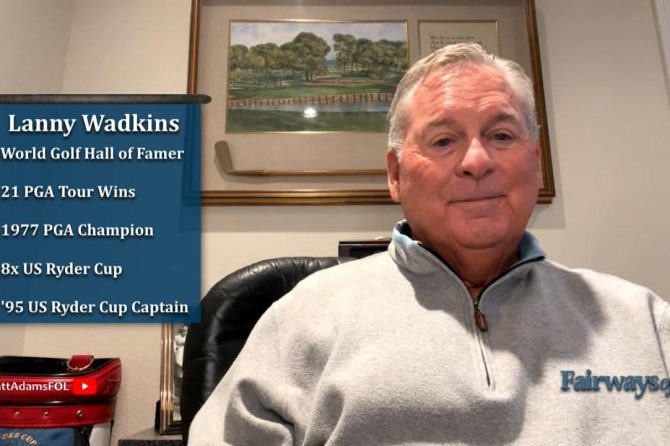Raymond Floyd, a distinguished figure in the world of professional golf, has made significant contributions not only through his achievements on the course but also as an influential golf instructor. His instructional beliefs is rooted in the dual pillars of technical proficiency and psychological resilience, offering a holistic approach to the game. Central to his teachings is the “Floyd Fade,” a distinct swing technique characterized by precision and consistency, which has been instrumental in shaping his success as a player and coach.
Beyond the mechanics of the swing, Floyd emphasizes the importance of mental strategies that empower golfers to perform under pressure.This dual focus—merging the intricacies of technique with the nuances of psychological preparedness—provides a thorough framework for players aspiring to enhance their performance. By analyzing Floyd’s methodologies, one can glean insights into the intricate relationship between technique and mindset, ultimately highlighting the multifaceted nature of golf mastery. This exploration seeks to uncover the essential elements of Floyd’s instructional philosophy, shedding light on how his legacy continues to influence golfers at all levels.
Exploration of the Floyd Fade Technique in golf Instruction
raymond Floyd’s “Floyd Fade” swing technique is a testament to the intricacies of golf instruction,combining mechanical precision with an understanding of the golfer’s psyche. This method emphasizes a controlled fade,which is notably advantageous on courses with dogleg holes or when the wind is a factor. The approach integrates elements such as grip adjustment, stance alignment, and swing path modification, allowing golfers to achieve a consistent and reliable fade. Key components include:
- Grip alteration: adjusting the grip encourages a more pronounced fade, where the trail hand is placed more on top of the grip.
- Stance Positioning: Aligning the body left of the target (for right-handed golfers) creates a natural swing path conducive to a fade.
- Swing Path Adjustment: An outside-to-inside path engages the clubface to create the desired spin and trajectory.
This technique not only enhances physical execution but also supports the mental framework necessary for competitive play. Floyd’s instruction incorporates psychological strategies such as visualization, which helps golfers mentally rehearse their shots before execution. This preparatory phase can reduce anxiety and enhance focus, resulting in improved performance under pressure. By marrying technical proficiency with mental readiness, the Floyd Fade embodies a holistic approach to mastering the game.
Furthermore, the effectiveness of the Floyd Fade technique can be benchmarked against traditional shot-making strategies. In a comparative analysis, we can observe how golfers apply the *Floyd Fade* versus other shot types, such as traditional draws or straight shots.Below is a summary table that highlights key differences:
| Shot type | Advantages | Ideal Conditions |
|---|---|---|
| Floyd Fade | Enhanced control, ideal for doglegs | Windy conditions, tight fairways |
| Traditional Draw | Increased distance, stable flight | Open fairways, favorable wind |
| Straight Shot | Predictable, versatile | General play, all conditions |
The Role of Sensory Feedback in Enhancing Golf Performance
In the quest for improved performance on the golf course, understanding the intricacies of sensory feedback is essential. Sensory feedback encompasses the information gathered by players through their senses, particularly **visual**, **auditory**, and **kinesthetic** inputs. This feedback forms the foundation of motor learning, guiding golfers in refining their swing mechanics. for instance, visual feedback allows players to assess their alignment and ball trajectory, while kinesthetic feedback gives insight into the feel of the club during a swing, enabling adjustments for better accuracy.
The importance of feedback mechanisms is further emphasized in various studies, which suggest that the type of feedback received can significantly influence motor skill development. Golfers benefit from both **intrinsic** feedback, which comes from their own sensory experiences, and **augmented** feedback, which is external and can take the form of verbal cues or video analysis. Utilizing this feedback effectively allows a golfer to correlate specific sensations with triumphant actions,thus enhancing their ability to replicate successful swings under pressure.
To illustrate the impact of sensory feedback on training programs, a comparison table below highlights various feedback types and their roles in skill acquisition:
| Feedback type | Description | Role in performance |
|---|---|---|
| Intrinsic Feedback | Information from one’s own body during movement. | Enhances self-awareness and motor control. |
| Augmented Feedback | External information provided after performance. | Guides adjustments based on coaching insights. |
Understanding Clubface Control for optimal Shot Accuracy
effective clubface control is foundational for achieving precise shot accuracy in golf. the orientation of the clubface at the moment of impact has a direct influence on the trajectory and direction of the golf ball. to maximize this control, golfers must focus on several core swing mechanics:
- Good takeaway: Ensuring the club is taken back on the correct path sets the stage for better impact.
- Neutral wrist position: Maintaining a proper wrist angle allows for more consistent clubface alignment.
- Proper rotation in the downswing: A smooth, coordinated body movement aids in maintaining clubface orientation.
- Forward shaft lean at impact: This position helps squaring the face against the ball for improved accuracy.
Another vital aspect of mastering clubface control revolves around understanding wrist dynamics. The wrists possess significant influence over how the clubface presents itself during the swing. Key movements that affect clubface control include:
- Flexion: Wrist flexion can alter the angle of the clubface, crucial for shaping shots.
- Extension: Extending the wrists appropriately is necessary for achieving a square clubface at impact.
- Rotation: Proper wrist rotation contributes to a natural swing path, allowing for greater consistency.
To further enhance understanding, golfers can employ practical drills that offer real-time feedback on clubface orientation. As an example, setting an alignment stick on the ground can provide a visual guide for ensuring the clubface is aligned correctly throughout the swing. Below is a simple drill setup that can be implemented on the range:
| Drill | Description |
|---|---|
| Alignment Stick Drill | Place an alignment stick 1-2 feet in front of the ball to serve as a target line. |
| Clubface Check | Before each swing, ensure the clubface is square to the stick. |
| Feedback Loop | Adjust grip and stance based on the ball’s trajectory post-impact. |
Mental Resilience: Developing a Strong Psychological Approach in Golf
Mental resilience is a crucial component of a golfer’s performance, requiring the ability to recover from setbacks and maintain focus under pressure. As articulated by performance coaches like David MacKenzie, effective mental training equips golfers with strategies to manage performance anxiety and stay composed during critical moments in tournaments. Key aspects of mental resilience include:
- Self-awareness: understanding personal triggers and reactions to stress enhances control during competitive play.
- Positive self-talk: Cultivating a constructive inner dialogue can mitigate negative thoughts that hinder performance.
- Visualization techniques: Imagining successful outcomes can foster confidence and reduce anxiety before and during a round.
Raymond Floyd’s approach emphasizes the importance of a strong psychological foundation, advocating for mental exercises that align with physical training. He encourages golfers to embrace adversity, viewing each challenge as an possibility to strengthen their mental toughness. This methodology promotes a mindset that is resilient in the face of criticism and failure, allowing golfers to:
- Learn from mistakes: Developing resilience means accepting errors as necessary steps towards improvement.
- Stay focused: maintaining concentration amidst distractions, both external and internal, is vital for optimal performance.
- Adapt to different situations: Flexibility in strategy in response to course conditions or personal performance can significantly influence results.
To effectively build mental resilience, integrating psychological strategies into regular practice is essential. Creating a structured training regimen that addresses both physical and mental aspects of the game can enhance overall performance. A practical framework for such an approach can be summarized as follows:
| Component | description |
|---|---|
| Routine Development | Create consistent pre-shot routines to foster familiarity and reduce anxiety. |
| Mindfulness Practice | Engage in exercises that promote present-moment awareness and concentration. |
| Goal setting | Establish realistic and measurable goals to track progress and boost motivation. |
Integrating Techniques and Psychology for Comprehensive Golf Mastery
Integrating technique and psychology into a cohesive approach is crucial for achieving mastery in golf, as demonstrated by the instructional philosophies of raymond Floyd. His teachings emphasize the importance of not only mastering the physical aspects of the game but also nurturing the mental resilience that underpins successful performance on the course. Understanding this duality can empower golfers to elevate their game significantly.
Floyd promotes various **techniques** that can be harmonized with psychological practices to optimize performance. These include:
- Proper Grip and Stance: Implement effective grip techniques that enhance control over the club and promote consistent ball striking.
- Routine Development: Establish a pre-shot routine that fosters focus, reduces anxiety, and conditions the mind for performance.
- Visualization Techniques: Encourage golfers to visualize successful shots, creating a mental blueprint that can enhance physical execution.
Moreover, psychological factors play a profound role in a golfer’s performance. Floy’ds methods reinforce the value of mental training alongside physical practice, articulating core principles such as:
- managing Anxiety: Employ methods like deep breathing or positive affirmations to alleviate tension during crucial moments.
- Goal Setting: Set specific, measurable, attainable, relevant, and time-bound (SMART) goals to foster a sense of purpose and direction in practice.
- Mindfulness: Encourage staying present during play to enhance focus and mitigate the effects of external pressures.
The synergy of technique and psychology not only equips golfers with critical skills but also prepares them mentally to face competitive challenges. By adopting a holistic approach,as advocated by Floyd,golfers can cultivate a resilient mindset and a refined skill set,laying a foundation for enduring success on the greens.
Raymond Floyd’s contributions to golf instruction encapsulate a profound understanding of both the technical and psychological dimensions of the sport. His signature “Floyd Fade” swing exemplifies the intricacies of swing mechanics through precision and adaptability, while his insights into the mental aspects of competitive golf underscore the importance of resilience, focus, and strategy.By integrating these elements, Floyd not only enhances players’ physical capabilities but also fosters a mindset that is essential for success on the course. This dual approach serves as a valuable framework for golfers at all levels, encouraging a holistic understanding of the game and the development of skills that transcend mere technique. As Floyd’s methodology continues to influence the golfing community, aspiring players can benefit from his teachings—adopting both the mechanics of the swing and the mental fortitude required for excellence in the sport.





